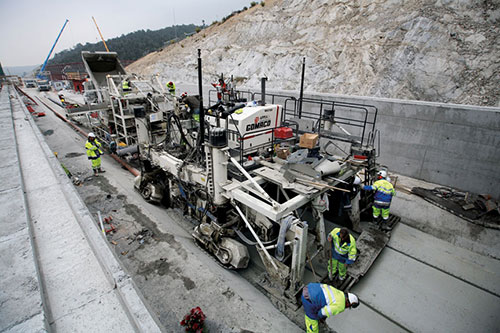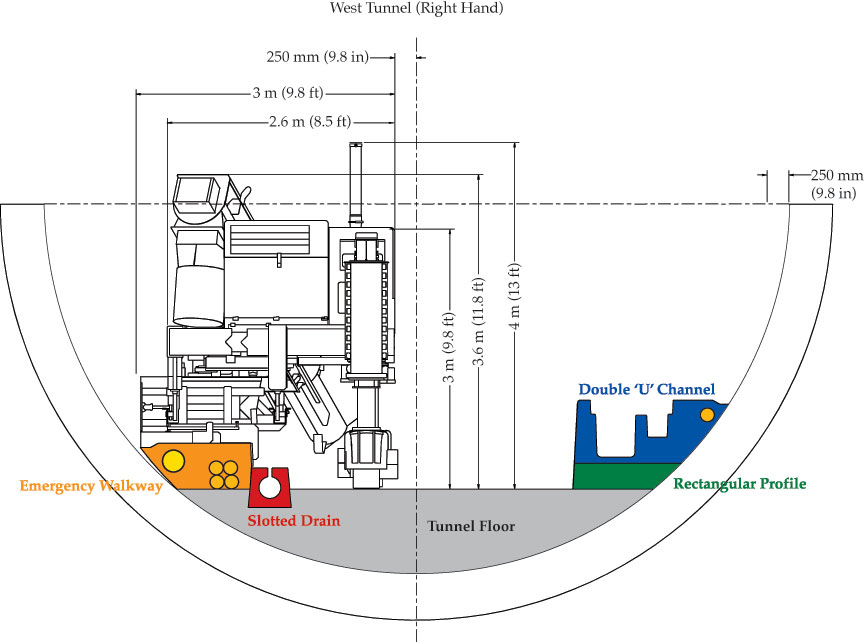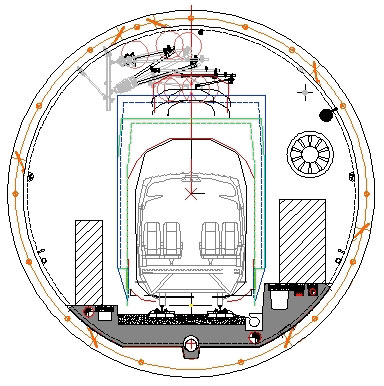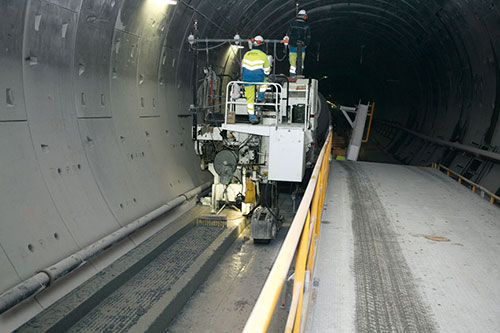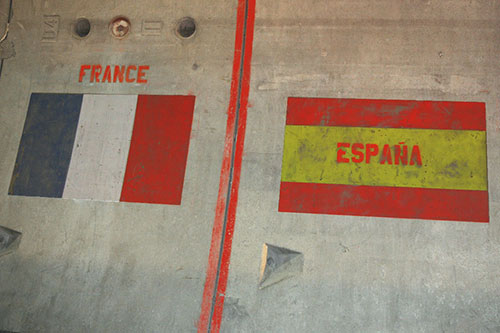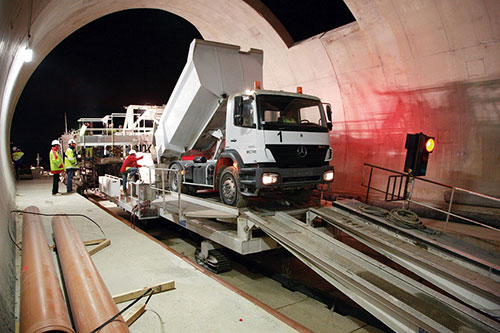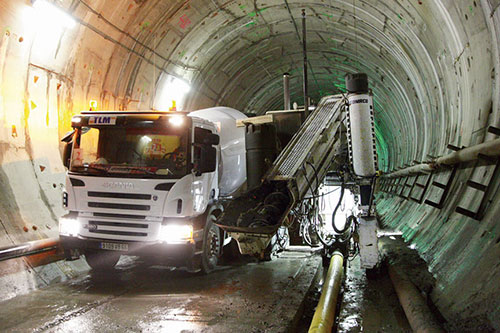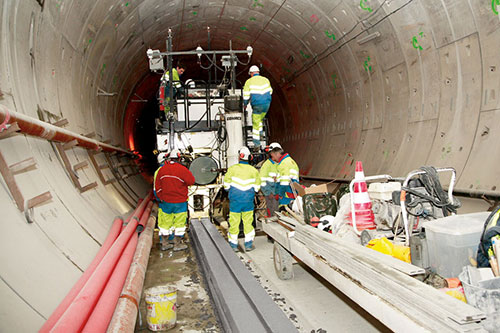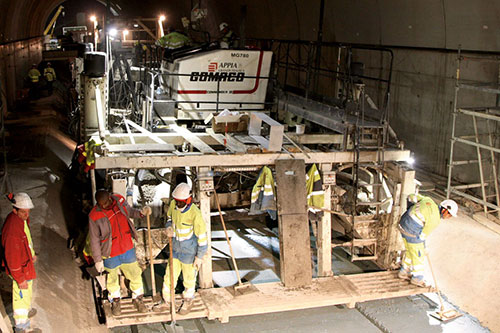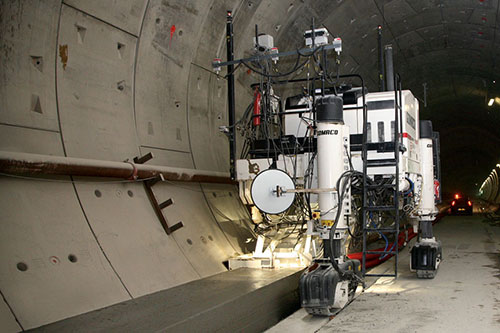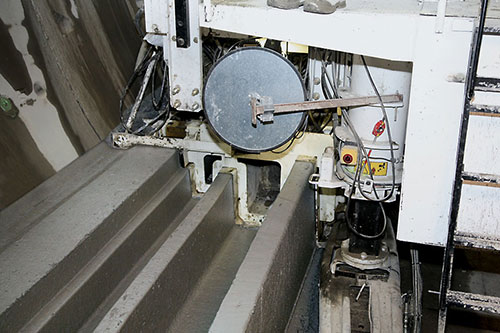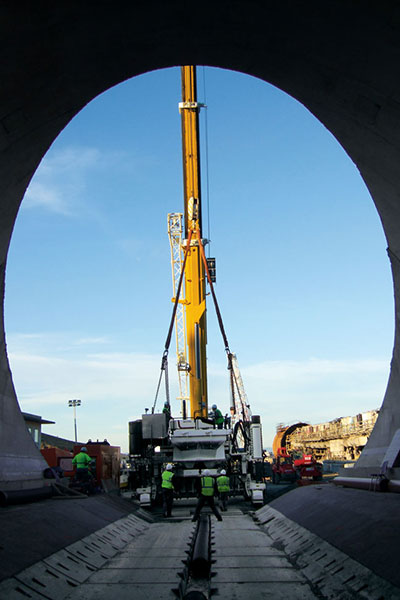GOMACO World Index --- GOMACO World 37.1 - June 2009
A High-Speed Connection Between France and Spain
The tracks on the Commander III were turned at 35 degree angles to run along the slope of the tunnel’s walls.
It’s a project of enormous size and expense, but it will ultimately link two countries via a high-speed rail link. Both tourists and freight will travel at speeds up to 300 km/h (186 mph) as they ride between Perpignan, France, and Barcelona, Spain. The journey used to take almost three hours to complete, but that time will be reduced to only 50 minutes with the new Train à Grande Vitesse (TGV).
“Le Perthus” tunnel is the link between Perpignan in France and Figueras in Spain in the French/Spanish border town of Perthus. Two 8.7 meter (28.5 ft) diameter tunnels, each 8.4 kilometers (5.2 miles) long, is part of the overall link connecting the two countries.
The work on the French side of the railway was completed by the contractor group, EIFFAGE Travaux Publics, France, based out of Lyon, France. Part of their responsibilities included slipforming the concrete base slab on which the railway for the high-speed track would be laid, and the two side platforms.
This would be the first tunnel project for the company. They turned to GOMACO and Metalliance, their GOMACO distributor in France, for guidance. They needed to slipform five different profiles inside the tunnel’s limited space. EIFFAGE chose to purchase three GOMACO Commander IIIs with the various mold profiles.
“We’ve been using Commander IIIs since 1996 and GOMACO’s experience working in tunnels was very important in our final equipment choice,” Fréderic Gratessolle, manager of the Large Project Concreting Pavement Division, said. “The other reason was the relationship between EIFFAGE and METALLIANCE. For this project to be a success, we knew we needed good partners.”
EIFFAGE’s first project inside the tunnels was slipforming the base slab, or tunnel floor. The floor had an average thickness of 600 millimeters (23.6 in) and was 5.6 meters (18.4 ft) wide. Cross slope of the floor varied between zero and 7.67 percent. Three different drainage pipes, varying in diameter from 250 to 400 millimeters (9.8 to 15.75 in), were incorporated into the floor during slipforming.
The Commander III four-track had its tracks turned at 35 degree angles to run along the slope of the tunnel walls. The inner leg tubes were turned 45 degrees from their normal position to accommodate the tunnel paving application.
Concrete was supplied by an on-site batch plant on the Spanish side of the tunnel. Ten specially-designed mixer trucks carried six cubic meter (7.8 yd3) loads of concrete to the paving site. Two special crossing platforms were fabricated inside of the tunnel to allow the trucks to pass by each other. A turntable in front of the paver swiveled the trucks 180 degrees so they could dump into the hopper of a custom-built concrete spreading system.
“I think the most difficult aspect wasn’t the slipforming, but delivering the concrete with trucks inside the tunnel,” Luc Riottot, Perthus Tunnel job-site manager, said. “When we paved the floor, we paved from France towards Spain in both tunnels. The system allowed the trucks to pass each other, turn around, and return back to the concrete batching plant.”
The Commander III was equipped with the Leica stringless guidance system and the Minnich Auto Vibe vibrator monitoring system. It also features the latest in GOMACO control systems, the G22, which has easy to understand icons and commands in full text French (or any other language of the contractor’s choice). The G22 easily interfaces with both the stringless guidance and vibrator monitoring systems.
EIFFAGE worked continuously, 24 hours a day, seven days a week, slipforming the tunnel floor. In eleven weeks time, they finished the floors in both tunnels, slipforming 48,000 cubic meters (62,781 yd3) of concrete.
With the floor complete, it was time to bring in their three-track Commander IIIs. Each was equipped with a high-drive track on the front leg for tight-clearance paving. The narrow track could run between the tubes and piping that had to be slipformed into the side profiles.
The first of the side profiles to be slipformed was a slotted drain with a 250 millimeter (9.8 in) diameter. The profile is designed to drain away any dangerous liquids that could potentially spill from the goods transport trains. The slotted drain was slipformed the length of one tunnel. Then the Commander III would be moved to the adjoining tunnel and slipform the drain back in the opposite direction.
Next to the drain, a rectangular profile was slipformed over a 250 millimeter (9.8 in) diameter drainage pipe and four 160 millimeter (6.3 in) diameter tubes for electrical cables. The profile was 495 millimeters thick (19.5 in) and 1.47 meters (4.8 ft) at its widest point.
With both profiles complete, it was time to begin work on the profiles for the opposite sidewall.
“We used two passes and two molds, because the complete profile was more than one cubic meter (1.3 yd3) of concrete and we thought that was too much to slipform in one pass,” Gratessolle said. “The first layer was a rectangular profile. On top of that, we slipformed a double ‘U’ channel profile. The channels will hold pressure water pipe for fire protection and a tube inside the concrete will house more electrical cables.”
The surface of the profile will also serve as a passenger walkway in case of emergency exits.
Trucks carrying concrete for the profiles would enter the tunnels from France, drive up on a ramp so they could get by the paver, unload onto the Commander III’s high-volume auger conveyor, and then exit the tunnel towards Spain.
“One of the difficulties of the project was the difference between the theoretical position of the tunnel and its real position,” Riottot said. “Sometimes we would have to manage up to 250 millimeter (9.8 in) differences. To resolve the issue, we used telescoping molds.”
By the time “Le Perthus” tunnel project was completed, EIFFAGE had slipformed 28,000 cubic meters (36,622 yd3) of concrete and five different profiles, each with a length of 16.8 kilometers (10.4 mi), for a grand total of 84 kilometers (52.2 mi). All of it was slipformed with GOMACO Commander IIIs and the Leica stringless guidance system.
“The Commander III is a versatile machine and with all of the different profiles we needed to pave, it was the key to the project,” Eric Bon, Technical Manager of the Division of Concrete Pavement, said. “Preparation is the most important thing for this kind of project and to win the challenge, you need partners who will stay with you from beginning to end. We had those partners in GOMACO and METALLIANCE.”
The Leica guidance system eliminated the hassle of stringline in the tunnel’s tight paving conditions.
Subscribe to Receive GOMACO World Magazine
